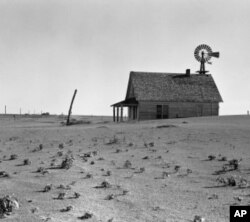Since the dawn of agriculture, tilling the soil has been fundamental to farming.
But today, experts say this age-old practice may do more harm than good, at least in some places. That's why they've been telling farmers to throw away the plow.
Kicking up dust
An enormous cloud of dust two kilometers high blew through Lubbock, Texas this October, after months of record-breaking drought and heat.
It brought back memories of the 1930s Dust Bowl era, when the region was devastated by frequent, severe dust storms.
Millions fled as their livelihoods blew away. One reason dust storms were more common in the 1930s, experts say, is that plowing was more common back then.
But while last month’s storm was severe, a return to the Dust Bowl days is unlikely.
"We have come a long way from those days where we had these kinds of occurrences as a common occurrence," says Texas state conservation chief Salvador Salinas.
'Throw away the plow'
For generations, plows carved up the soils of the Texas High Plains, as they do the world over. Turning the soil controls weeds and prepares the land for planting. But tilled earth erodes more easily in the wind and rain.
Bram Govaerts has seen the impacts of erosion in Mexico, where he heads the conservation agriculture program at the International Maize and Wheat Improvement Center.
“There is a percentage of area in certain states of Mexico where farming is no longer possible because we already eroded those areas,” Govaerts says, suggesting a different approach. "Throwing away the plow. No longer plowing. No movement of soil."
Reducing soil erosion
Farmers in the Texas High Plains till just a strip of soil where the seed and fertilizer go. The rest is left alone. And the stalks and leaves they used to till under, are now left behind, says farmer David Ford.
“Everything in between these rows is the organic matter left from the wheat straw, which helps keep the ground covered, reduces soil erosion.”
Keeping the ground covered helps shield the precious soil from wind and sun, and keeps moisture from evaporating. In this year’s extreme drought and heat, minimal tillage and maximum cover made a big difference, says Brandt Underwood, an agronomist with the U.S. Department of Agriculture.
“It’s my opinion that the strip till system right here and the residue management is what’s enabled David to produce this kind of corn crop in this drought-type year.”
Added benefit
Plowing less also saves money.
“We don’t have to burn the fuel that we used to burn," says Ford, the farmer. "Our equipment will last longer.”
And it’s not just for big American farms. Bram Govaerts says his agency is helping design equipment for small farmers in developing countries, too.
“We want to have machines locally built so that the local small businesses also get better from the improved technologies.”
Research shows farmers get as good or better yields using these methods while saving money on their production costs. That means when it comes to the age-old practice of plowing, less really is more.















